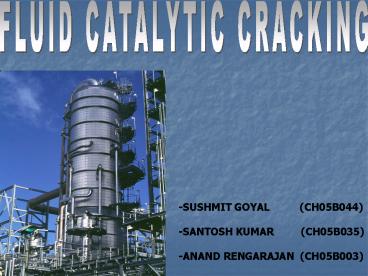FLUID CATALYTIC CRACKING - PowerPoint PPT Presentation
1 / 15
Title:
FLUID CATALYTIC CRACKING
Description:
USE OF BAFFLES. BUT NO THEORY,ALL IS EMPERICAL. ZEOLITE. TETRAHEDRAL GEOMETRY ... FCC units use a dense, moving fluidized bed operating in either the bubbling or ... – PowerPoint PPT presentation
Number of Views:6890
Avg rating:5.0/5.0
Title: FLUID CATALYTIC CRACKING
1
FLUID CATALYTIC CRACKING
-SUSHMIT GOYAL (CH05B044) -SANTOSH
KUMAR (CH05B035) -ANAND RENGARAJAN
(CH05B003)
2
THE GENERAL PROCESS
- FEED (GAS OIL) IS HEATED
- BROUGHT IN CONTACT WITH CATALYST
- FLUIDIZATION
- BUBBLE,PARTICULATE, SLUG AND TURBULENT
- CRACKING
- POISONING OF CATALYST
3
THE GENERAL PROCESS(CONT)
- SEPERATION
- CYCLONES-EFFICIENCY 99.995
- REGENERATION
- REINTRODUCTION IN THE REACTOR
- FLUE GAS
4
OUR FOCUS FOR THIS PRESENTATION
- CHALLENGES
- CATALYST ROLE
- MODELING AND SIMULATION
5
CHALLENGES AND USE OF ENGINEERING
- THERMAL CRACKING
- NON UNIFORM
- USE OF INJECTOR
- USE OF BAFFLES
- BUT NO THEORY,ALL IS EMPERICAL
6
ZEOLITE
- TETRAHEDRAL GEOMETRY
- CONTAINS VACANT SITES(PORES)
- PREFERENTIAL CRACKING
- ZEOLITE TYPES
7
OPTIMIZATION!
8
MODELLINGLMPA IMPREGNATION OF CATALYST
9
MODELLING(CONT)
- PARTICLES DIFFER IN PROPERTIES
- NEED FOR AVERAGE PROPERTIES
- SO A PROPOSED CONCEPT
- STAGED CRACKING
10
STAGED CRACKING
- PORES INTERIOR
- TO EXTERIOR
- SIZE OF PORES VARY
- ACHIEVES BETTER
- CRACKING
11
Freely bubbling bed of FCC catalyst and Simulation
- Four regimes of fluidization Particulate,
Bubbling, Slugs, Turbulent. - FCC units use a dense, moving fluidized bed
operating in either the bubbling or turbulent
regime. - Computational Fluid Dynamics (CFD) for
understanding fluidization hydrodynamics. - Reason for model failure use of mean bubble and
emulsion properties. - Bubble sizes and velocities exhibit a
distribution about the mean value, affecting the
predicted hydrodynamics.
12
Bubble splitting and Coalescence
- Four groups of particles Geldart A particles
(fine) and Geldart B particles (coarse), Geldart
C, Geldart D. - Bubble splitting and coalescence important
phenomenon associated with Geldart A bubbling
beds. - Factors gravity and drag are the dominant
terms, the solids phase stress predicted by
kinetic theory play a minor role. - Poor simulation results Cohesive interparticle
forces neglected.
13
- ECT (Electrical capacitance tomography) is used
to obtain dynamic tomographic images of the
entire cross-section of the fluidized bed.
14
Challenges in understanding bubbling fluidization
- Cohesive forces important for FCC fluidization.
- Challenges implementing realistic equations to
represent these forces. But the calculation of
Van der Waals forces is at present very
approximate. - Discrete element method (DEM) uses individual
particle tracking. A Multiple of the single
particle buoyant weight to calculate cohesive
forces. - Problems with DEM computational requirements is
proportional to the number of particles !!!
15
BIBLOGRAPHY
- FCC HANDBOOK
- - REZA SADEGHBEIGI
- CATALYST TODAY 18(1993) 509-528
- -R MANN
- POWDER TECHNOLOGY 163(2006) 2-8
- YE-MON CHEN
- POWDER TECHNOLOGY 129(2003) 139-152
- TIM MCKEEN AND TOD PUGSLEY
- OTHER INTERNET RESOURCES































